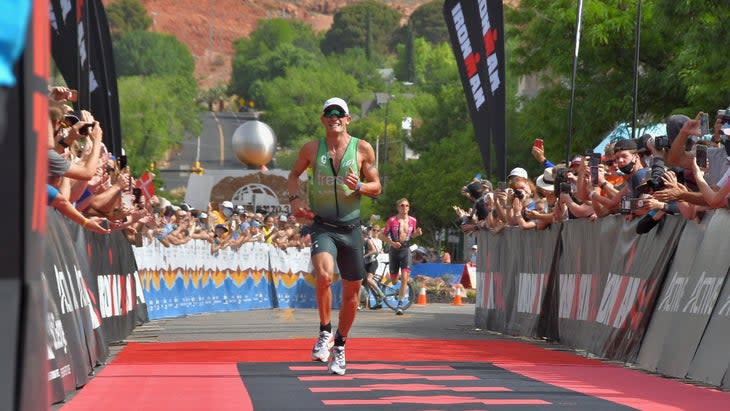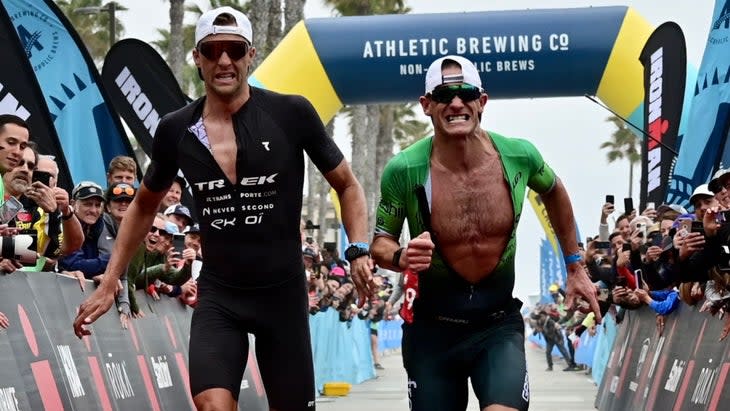Lionel Sanders and the Art of the Sprint Finish
- Oops!Something went wrong.Please try again later.
- Oops!Something went wrong.Please try again later.
This article originally appeared on Triathlete
Never has a running style in triathlon been critiqued as much as the one possessed by Lionel Sanders. How he covers the ground so fast when appearing to shuffle with a hitch in his stride is the physics-defying spectacle that leaves the skeptics agog - even more so as the Canadian invariably leaves his challengers for dust.
But it's not just the unusual style. It's also that when it comes to the death throes of a race and a dramatic sprint finish - Lionel takes it out. Time after time.
Perhaps it's no coincidence, given the racing dustups he so relishes, but Sanders also seems to be involved in more of these sprint finishes than just about any triathlete on the planet. And after his latest head-to-head blowout with Sam Long at this year’s Collins Cup, Triathlete decided it's high time to do a bit of analysis on his sprinting ability, to decipher why Sanders is the clutch performer when it comes to the crux.
We tapped Jorge Martinez, who specializes in metabolic testing and biomechanics at the FreeSpeed Lab, to look at some of the most dramatic finishes, with some added color from Lionel's candid post-race appraisals on his YouTube. Here's what we've learned about the fine art of the sprint finish.
RELATED: Lionel Sanders Fuels with Maple Syrup. Should You?
Lionel Sanders v. Pablo Dapena Gonzalez
Challenge Daytona, December 2019

What happened:
Being under the lights on the Daytona Speedway in Florida only added to the atmosphere as Sanders' Spanish rival continually surged in an effort to break the Canadian's will. Sanders was honest enough to admit that Dapena hadn't been on his radar until the build-up to this clash, but just a week after an Ironman 70.3 win in Indian Wells, he had enough in the tank to claim victory.
"Pablo threw like eight surges where I was truly sprinting - putting gaps into me and I kept working and working. With maybe 1 1/2 miles to go, he put in a surge, and I said I've got one shot: go with the surge and just keep the pace up. I got a little gap and I said: 'You gotta go.' I felt my right hamstring with every step, so I was saying: 'Don't cramp. Don't cramp.' It might be the best race I've ever done. The best battle I've ever had."
Coach Jorge says:
"From the times I've analyzed Sanders’ run performances, it appears his energy cost of running (ECOR) doesn't get affected as much as other athletes when they fatigue. The ECOR is how much speed we get in return for the power we generate. If you can run at a faster speed with less running power, it means your running is more efficient. I don't have direct data (i.e., power files), but the estimates I've calculated from Sanders' racing data and video footage are consistent. Pablo's energy cost of running may have been better than Sanders initially, but as he fatigued with repeated surges, eventually it may have cost him slightly more energy - allowing Sanders to take victory."
RELATED: Stay or Go? When to Follow the Race Plan (and When to Go for Broke)
Lionel Sanders v. Sam Long
Ironman 70.3 St George, May 2021

What happened:
The longest of sprints in Utah captured the imagination of tri fans the world over. Sanders and Long were in lockstep for the final 5 kilometers and arrived at the line at such pace the run-off area hardly had enough space to contain Long's momentum. It was a classic piece of endurance sport theater, as both refused to yield before Sanders finally opened a gap with the line in sight.
"I just started sprinting with about half-a-kilometer to go. It's hard to look directly behind you so I had no idea how big the gap was, but it felt like it was about 10 meters. So, I sprinted into the final roundabout, looked back and he's still in striking distance. I didn't want to let him think there was any possibility he might catch me. I came to the finish line and just the emotion of a great battle came out, Normally I'm chockful of anger and pure adrenalin, this time it was like a different emotion, the first time I had a couple of tears in my eyes at the finish line."
Coach Jorge says:
"Long would gain time on Sanders on the descents, but Sanders would pull it back on the inclines and 'flats'. This is due to Sanders been a 'terrestrial' type of runner which means, he has a shorter flight time, shorter stride (147cm), faster cadence (200 spm), short ground contact time (200 milliseconds) and lower vertical oscillation (5cm), using his muscle strength to generate propulsion from each stride. Long on the other hand is more of a 'aerial' runner with a longer flight time, longer stride (164cm) slower cadence (182spm), higher ground contact time (205ms) and vertical oscillation (7cm). He also can generate a good amount of propulsion, but in a slightly different way, his tendons and connective tissue helping to get more energy return per stride. In the last 2.5km, Long was able to catch Sanders during the descent, but as soon as they had around 1km to go and the road flattened out, Sanders was able to increase his cadence, increasing his propulsion enough to build the final gap."
RELATED: How to Run Smarter in Hilly Races
Lionel Sanders v. Rudy Von Berg
Ironman 70.3 Oceanside, April 2022

What happened:
The closest finish of the lot. So close, in fact, that the organizers weren't set up for it and needed unofficial camera film footage to separate the two. Sanders had been forced to bike conservatively after an issue with his nutrition and started the run adrift. His 68-minute half-marathon - the fastest of the race - wouldn't be enough to catch compatriot Jackson Laundry, but took him past Ben Kanute and Alistair Brownlee and up to Von Berg for the final sprint for second.
Lionel's view: "I caught Brownlee with 600 meters to go. He didn't respond - he didn't care. Then Rudy was right there. I surged again to catch, but I'd been working since mile 11 1/2 and we're 200 meters from the finish. I was going to take an opportunity to chill for a moment before the final sprint, but I must have startled him because the moment I caught him he started sprinting, so there was no reprieve. I started sprinting too. Every muscle fiber in my body was engaged - back and forth, back and forth, and I had a tiny bit more. I knew it was controversial who won, but in the moment it was clear as day that I out-leaned him. It's a weird situation when you get in a fun battle like that but it's not for the win. But the positions weren't what motivated me, I just love the battle."
Coach Jorge says:
"The advantage Sanders may have as a terrestrial power runner versus a more aerial type of runner (see 70.3 St George analysis above) is that during a final sprint, as long as he has a bit extra in the tank, he can increase his cadence quite a bit without increasing other aspects like his vertical oscillation. This results in each step gaining a bit more propulsion and coupled with his 'no limits' motivation to beat whoever is in front of him gave him the edge."
Lionel Sanders v. Braden Currie
Ironman World Championship, St George, May 2022

What happened:
Sanders managed to take down long-time leader Currie in the final yards to claim a second runner-up spot in the Ironman World Championship - five years after first making the podium in Hawaii. With the second-fastest marathon of the day (2:42) on a rolling course, patience paid off as Sanders pulled back five minutes on the run, and caught the plucky Kiwi just before the line.
"I'm at mile 24, the gap is 60 seconds, and I took it one gear more. I made a left turn to the out-and-back section before the finish and now tactics were coming in too. I knew at the final turnaround I needed to have the element of surprise, and pulled back as much time as I could because he'd get a second wind if he saw it was a good gap. I worked hard into the corner and had it down to 100 meters - it was hit and miss. At about 400 meters to go, I was coming right up on him. I made the mistake in Oceanside of coming up next to Rudy (see above) and taking a break, so this time I made sure to surprise. I took a few breaths and then I made the move and I think that element of surprise was enough to create a big enough gap. I made the final left turn, and the crowd were going crazy. It was completely overwhelming."
Coach Jorge says:
"Sanders approached the World Championship differently to other races and was more disciplined on the bike and early part of the run, sticking to his pacing and fueling strategies. In my opinion, it allowed him to sustain a consistent pace throughout the entire marathon. More so, it allowed him to speed up in the final miles while Currie was slowing - outpacing him by up to 30 seconds per mile. Add to this his incredible ability to block the pain as he lets adrenaline fuel him through the finishing miles."
RELATED: Video: Lionel Sanders on His Epic Sprint and “Insane” Day
Lionel Sanders v. Sam Long (Again)
Collins Cup, Slovakia, August 2022

What happened:
Still fresh in the memory, there was a sense this battle was won for both men before the sprint ensued in the x-bionic sphere in Samorin. Objective number one seemed to be to bury Sam Laidlow and avenge Long's "beef" with his European rival. Once soundly achieved, it shaped up to be a repeat of the St. George 70.3 duel for the duo. Lionel pulled ahead while entering the finish arena; Long, in his final race of a European summer tour, looked satisfied to settle for second.
"I was waiting, waiting, waiting for him, keeping an eye to see if he was going to go first. With 200 meters to go, I decided it's now or never, so I went full tilt and the gap opened up. I grabbed the Internationals flag, tried to soak in the crowd a tiny bit and screamed in carnal joy when I crossed the finish line."
Coach Jorge says:
"When Sanders beat Long at St. George 70.3 last year, he was able to open a gap at the last water stop and increased his cadence from 195 steps per minute (spm) to 205 spm while Long stayed around 180spm. At the Collins Cup, Sanders draws on this experience. As favorite for the match, when the pressure was on, he found the extra gear and was able to dig that bit deeper."
RELATED: Recalled: 3 Crazy Sprint Finishes
For exclusive access to all of our fitness, gear, adventure, and travel stories, plus discounts on trips, events, and gear, sign up for Outside+ today.

